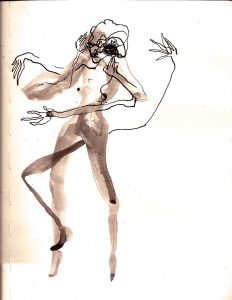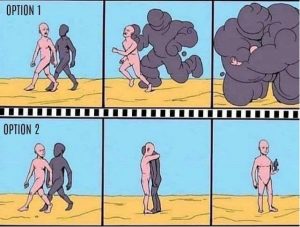Shadow Work (Upd: Nov 04, ’22)
Our petrified idea of the theatre is connected with our petrified idea of a culture without shadows, where, no matter which way it turns, our mind (esprit) encounters only emptiness, though space is full. But the true theatre, because it moves and makes use of living instruments, continues to stir up shadows where life has never ceased to grope its way. – Antonin Artaud¹
Hidden edges/repressions/blind spots or dark points* are like a field of treasure for personal and deep artistry. Follow these steps to take the warrior’s journey into your own psyche, a journey of sacrifice. Peter Brook notes, “The act of performance is an act of sacrifice, of sacrificing what most men prefer to hide – this sacrifice is his gift to the spectator.”5
Let your limitation ground you. A shadow can be a limitation or a boundary. Limitations can be the starting ground for creativity. Find your limits and when those are found then the dance can begin.
Tatsumi Hijikata opens up his important writing known as To Prison by noting how the start of him viewing the world as an unhappy place was when his father got beaten up. He called incidents like this bleeding nature, mentioning that these incidents could be fruitful and that there must be more of them.9

Shadow work takes on the journey of Jo-Ha-Kyu or Jo-Ha-Kyu-Jo, which are the main parts of a story: (1) Thesis (problem or lead); (2) Antithesis (working with the problem or alchemical process); (3) Synthesis (solution or gold). These stages are to be journeyed with movement or dance. This involves finding the twist (Jo), entering the twist (Ha) to climax (Kyu), and concluding with the reverse or new twist (Kyu/Kyu to new Jo). Sondra Fraleigh, who makes heavy use of alchemy in relation to butoh noted, “Butoh alchemy prepares me for uneven footing.”4 Let the journey begin.
Hijikata’s Flower of Kan represents moments of resonating with that which one cannot resonate with. Kan is the edge or difficulty and flower is the synthesis, resonance/transcendence/transformation of the difficulty. Rhizome Lee looked over Hijikata’s entire butoh-fu and located select kan qualia he felt were severe.6
0. Preliminary
Before embarking, you must be in a comfortable space. You must also have nurtured yourself well already.
1. Search for the shadow. (Jo)
You can also ask yourself a big question such as, “What is the underlying problem right now?, “How am I really doing?”, “What do I really need right now?”, or “Should I confess something?” Once you get a feeling or answer back, go on to step 2.
2. Feel the shadow. (Jo)
Observe the feeling/dark entity/poison in a third person perspective. There are many ways we can feel. Identifying an unsure feeling is a good start. Gradually solve the riddle from there. There might be more than one feeling/dark entity/poison, but just pick one. Simply see the feeling/dark entity/poison externally from a distance and without passing judgement. If you want suggestions on creating distance, refer to section on boundaries. Feel, but also embrace the warrior, and do not take the feeling personally.

3. Become the shadow. (Ha to Kyu)
While keeping your inner warrior, compassionately ask the feeling/dark entity/shadow what the possible solution, negotiation, or request might be and wait for the response. Feel the response. Place yourself inside the feeling/dark entity/poison knowing that this state is only transitory. Feel any slight release/limit/climax (kyu). Give thanks to the feeling/dark entity/poison.
4. Integrate/Transcend the shadow. (Kyu/Kyu to New Jo)
Return to your prior position, seeing the feeling/dark entity/poison under a new lens, and transformed into an ally or medicine. You become a stronger or more complete you with the help of this ally or medicine. You’ve reached the gloominous stage, shadow and light integrated. If you have reached this step through a major shadow, you ought to reward yourself in some way when your research is complete for the day.
Note: If the edge is too strong, you don’t need to force yourself to go forward. You can put it back in your pocket, and believe me, it will be waiting there for you if you so wish to venture there again. Even a tiny amount of integration or shadow souvenir is big progress. Be happy with even a little.
Exercise: I Accept Myself Despite…
Complete the prompt with movement. Resonate.
Find Your Inner Monster
Jordan Peterson explains why it is important to find your inner monster.
“[It] is impossible to respect yourself until you grow teeth. And if you grow teeth, you realize that you’re somewhat dangerous, or seriously dangerous. Then you might be more willing to demand that you treat yourself with respect and that other people do the same thing. That doesn’t mean that being cruel is better than not being cruel. What it means is that being able to be cruel, and then not being cruel, is better than not being able to be cruel, because in the first case you’re nothing but weak and naive, and in the second case you’re dangerous but you have it under control.” – Jordan Peterson8
Exercise: Mirror Shadows
This is an exercise to be done in front of a mirror in the dark with one candle. One is to focus on one’s face for a long while (30 minutes or more), and see the various personalities that come about. Many may be scary, absurd, or aged. When they come about, know they are aspects of yourself (subpersonalities), and that you accept them in yourself. These can also possibly be useful for finding butoh characters.
Kan Qualia
Rhizome Lee mentioned the term kan which means any moment of non-resonance (dissonance). There will always be many things in life that one does not resonate with. To try to resonate with these things regardless can lead to a nice creation or flower. Thus, the flower of kan, is the end result of integration/transcending of something that does not resonate.
Lee accumulated a list of what he felt was especially difficult things to resonate with from Tatsumi Hijikata’s butoh-fu. See list here.
Exercise 1: Dancing to your most despised song
Play the song you despise the most and try to dance to it. Allow yourself to feel all that surfaces and is it as material for the dance.
Exercise 2: Dancing with your most unliked food item
Bring a literal item of food or fruit which you most do not like and this will be your dance partrner/the thing that dances you.
Sen-Shin-Hitsu
Sen-Shin-Hitsu is another approach to shadow work created by Rhizome Lee. The first thing to be done is to empty and nurture oneself in order to be able to receive.
- Sen means “fresh,” “novel,” “new,” and/or “interesting.” Feel any strange or new subtle tendencies by moving in any various unique/twisted way. This is form to essence, or form provoking essence.
- Shin means “deep.” Simply feel any new feelings that are connected to our depths or deep childhood memories, and may often be an or edge, trigger, or kan.
- Hitsu means “necessary.” Go into any of the depths, but only to what seems necessary. If we go in too quick, we may do ourselves a disservice. To Antonin Artaud, this is the essential theatre:
The essential theatre is like the plague, not because it is contagious but because, like the plague, it is the revelation, the foregrounding, the exteriorization of a latent depth of cruelty that enables all of the perverse possibilities of the spirit to manifest themselves in an individual or a people.7
For more on edge approach, see the psychodrama/ritual Paper Edge.
Length of Time
Shadows come in varying intensities. Some shadows may be identified within 5 minutes but others may take years. Recent shadows are easier to find than not so recent ones. Because of this, not so recent shadow research may be taken outside of the realm of the studio or exploration space, but with precaution.
Triggers
A trigger is a psychophysiological response to an associated sharp shadow or trauma provoked by something in the environment experienced by one or more of the senses.² One may also feel that their body has betrayed them because the mind might think the situation is small, but the automatic body response paints a different picture. Example trigger feelings: (1) overwhelming feeling; (2) numbness; (3) spaced out; (4) asphyxiating; (5) a bomb explosion.³ Very often when these triggers are met, the only thing one wishes to do is to flee from them in some form via distractions or indulgences (food, substances, habits). Fortunately, we can use another response which is butoh theatre.
If a trigger happens, it is highly encouraged to attempt to engage, deconstruct, and resonate with it as much as possible. If a trigger happens during practice, it is an opportunity to engage in shadow work. Step 1 (Jo) of the 4 steps of shadow work (see above) already engaged itself, and so you can direct yourself to the preliminary step (comfortable space, nurture) followed by step 2 and attempt to complete the process. If the work is too difficult, do not shame or guilt yourself, but instead accept your place in the self-work.
Can we find the calm within the commotion, the calmotion?
High Intensity Edgework
There is a type of high intensity work that butoh artists such as Diego Pinon and Coco Villarreal engage in. The pattern which can be called a ritual involves getting participants into a high stress physical and/or psychological and/or emotional state until the limits are reached or breached. The participant will have given a signal of having enough. At this point, a dance begins.
Such an extreme requires a very conscious facilitation for safety. The facilitator takes on a lot of responsibility and must be ready for anything. The facilitator should also stress that the participant has their own responsibility to know their limits. Coco supplements the ritual with sound, voice, and smudging. The high intensity will have been worked up to via prior exercises and warmups.
Example rituals:
- A circle forms connected with rope and one participant throws the body onto the rope only to be slung back via the collective effort of those around the circle. This goes on until the participant is exhausted or has had enough and raises arms as to signal submission. If another intensity ritual is not added onto this, the improvisational dance will begin at the center of the circle.
- One participant is followed by a crowd of people making fun of the participant with words and body language. This goes on until the participant has had enough and raises their arms. Then the dance begins.
One criticism of high intensity edgework is that the participant might not be able to surpass the state of antithesis which leads to synthesis. In other words, the ritual will have not found a resolution, and if this happens, the exercise could create new emotional and/or psychological issues or make prior ones worse. Caution is advised.
